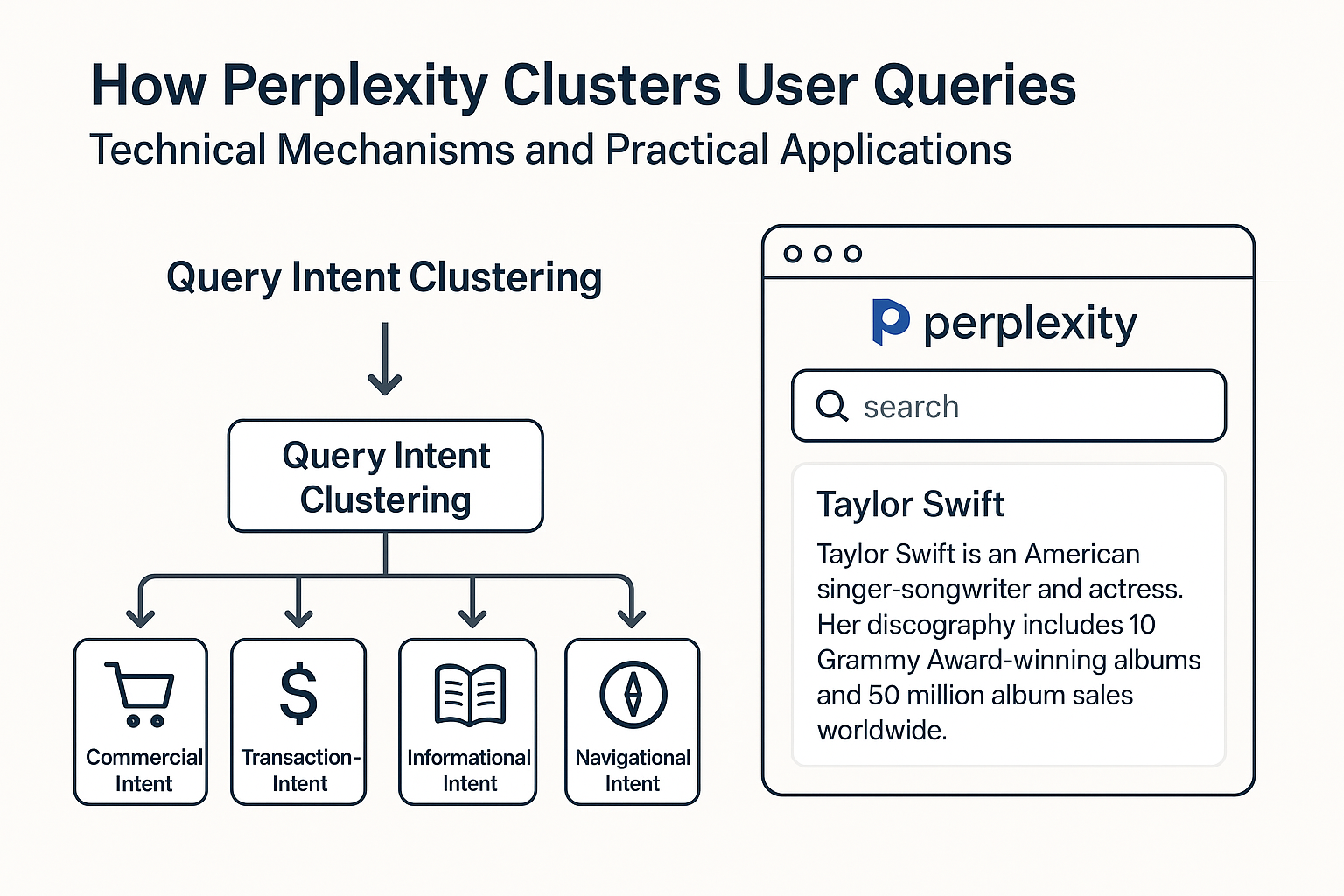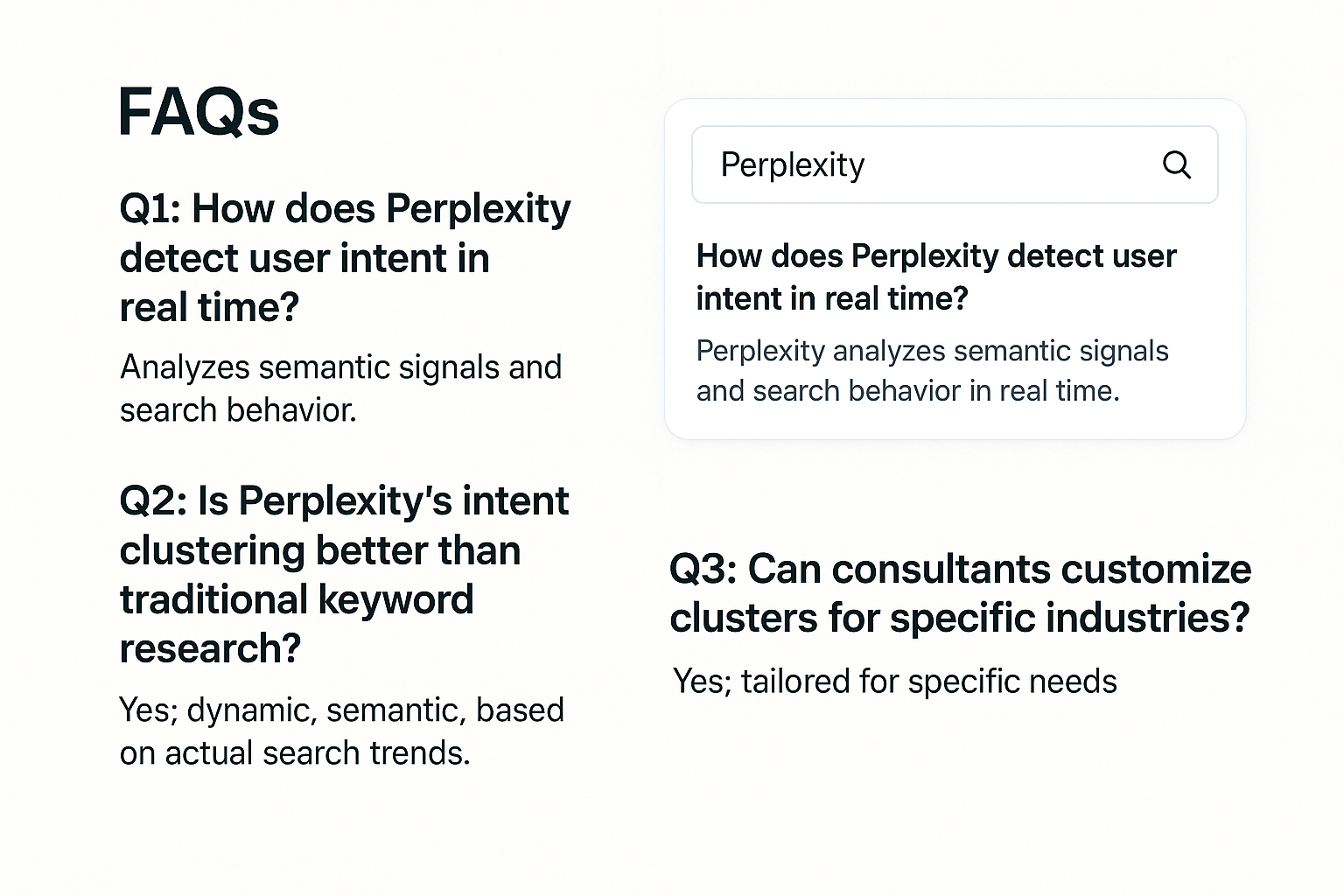How Perplexity clusters user queries into intent groups?

Summary (TL;DR)
Perplexity clusters user queries into intent groups by leveraging advanced semantic analysis, real-time search behavior, and configurable algorithms that classify queries by commercial, informational, navigational, or transactional intent[[1]](https://semai.ai/ai-answer-engine-optimization-tool/ai-query-keyword-generator)[[3]](https://metehan.ai/blog/perplexity-ai-seo-59-ranking-patterns/)[[5]](https://www.geekytech.co.uk/how-ai-interprets-search-intent/). This enables marketing and SEO consultants to map, prioritize, and optimize content around high-value user needs, elevating topical authority and conversion opportunities.
Introduction
Modern search engines and AI-driven platforms prioritize user intent, recognizing that understanding why users search is essential for delivering relevant results. Perplexity AI stands out by grouping user queries into intent-based clusters, enabling content strategists to align their pages and campaigns with actual search behavior. For SEO consultants, mastering Perplexity’s clustering mechanism provides a blueprint for increasing rankings, conversions, and ROI.

How Perplexity Clusters User Queries: Technical Mechanisms and Practical Applications
What Is Query Intent Clustering and Why Is It Critical?
Query intent clustering involves grouping multiple user queries with similar underlying motivations. Rather than simply linking keywords, this approach organizes queries by the intent—such as wanting to buy, research, navigate, or solve a problem—thus allowing marketers to build content that truly answers user needs[[1]](https://semai.ai/ai-answer-engine-optimization-tool/ai-query-keyword-generator)[[2]](https://www.airops.com/prompts/topic-clusters-perplexity-ai-seo-prompts)[[5]](https://www.geekytech.co.uk/how-ai-interprets-search-intent/).
- Commercial, transactional, informational, navigational intent: Content clusters can be built to target each type, driving more qualified traffic and improving user experience[[1]](https://semai.ai/ai-answer-engine-optimization-tool/ai-query-keyword-generator).
- SEO impact: Search engines use intent signals to rank pages; grouping queries by intent boosts topical authority and relevance[[7]](https://globerunner.com/seo-topic-clusters-and-ai/).
Technical Breakdown: Perplexity’s Clustering Architecture
Perplexity’s clustering mechanism is powered by a modular system utilizing several key technical processes[[3]](https://metehan.ai/blog/perplexity-ai-seo-59-ranking-patterns/):
| Component | Purpose | Key Configuration Parameters |
|------------------------------- |----------------------- |------------------------------------------|
| Trending News Index | Groups time-sensitive queries | trending_news_index_name, trending_news_minimum_should_match, trending_news_block_words |
| Suggested Query Index | Clusters evergreen queries | suggested_index_name, suggested_num_per_cluster, suggested_block_words |
| Fuzzy Deduplication | Cleans similar queries | fuzzy_dedup_enabled, fuzzy_dedup_threshold |
| Autosuggest Overlay | Boosts presentation | autosuggest_enabled |
- Semantic Analysis: Queries are analyzed for linguistic and semantic similarity, ensuring high-intent queries are grouped while noisy or duplicate variants are filtered out[[3]](https://metehan.ai/blog/perplexity-ai-seo-59-ranking-patterns/)[[4]](https://www.singlegrain.com/marketing/5-powerful-perplexity-ai-marketing-applications-you-need-to-know/)[[5]](https://www.geekytech.co.uk/how-ai-interprets-search-intent/).
- Deduplication Thresholds: Using fuzzy logic, highly similar queries are merged, consolidating traffic and intent for more robust cluster formation. This prevents fragmentation and aligns content to true audience demand[[3]](https://metehan.ai/blog/perplexity-ai-seo-59-ranking-patterns/).
How Does Perplexity Classify Query Intent?
Perplexity utilizes a combination of semantic signals, behavioral data, and modular intent classifiers to assign queries to intent types[[1]](https://semai.ai/ai-answer-engine-optimization-tool/ai-query-keyword-generator)[[2]](https://www.airops.com/prompts/topic-clusters-perplexity-ai-seo-prompts):
- Intent Classifier Module: Assigns each query to one of several major intent categories.
- Volume and Context Analysis: Tracks search volume and user context to determine which clusters need immediate attention versus long-term investment[[1]](https://semai.ai/ai-answer-engine-optimization-tool/ai-query-keyword-generator)[[3]](https://metehan.ai/blog/perplexity-ai-seo-59-ranking-patterns/).
- Competitive Gap Identification: Surfaces missing topics within clusters compared to competitor content, identifying clear opportunities for new pillar pages and supporting articles[[1]](https://semai.ai/ai-answer-engine-optimization-tool/ai-query-keyword-generator)[[2]](https://www.airops.com/prompts/topic-clusters-perplexity-ai-seo-prompts)[[6]](https://www.semrush.com/blog/perplexity-ai-optimization/).
How Can SEO Consultants Leverage Perplexity’s Intent Clusters?
Marketing and SEO professionals can achieve the following strategic goals by understanding Perplexity’s clustering approach[[1]](https://semai.ai/ai-answer-engine-optimization-tool/ai-query-keyword-generator)[[2]](https://www.airops.com/prompts/topic-clusters-perplexity-ai-seo-prompts)[[6]](https://www.semrush.com/blog/perplexity-ai-optimization/)[[7]](https://globerunner.com/seo-topic-clusters-and-ai/):
- Content Alignment: Match page topics, structure, and calls-to-action with high-converting intent clusters, improving both engagement and conversion rates.
- Pillar and Cluster Organization: Build out pillar pages that anchor major intent groups, then link supporting cluster pages for deeper topical coverage.
- AEO Optimization: Ensure clusters are formatted and linked in ways that maximize visibility in Google's AI overviews and answer engines.
- Efficient Ideation: Skip weeks of manual keyword research by tapping into Perplexity’s automated cluster generation[[1]](https://semai.ai/ai-answer-engine-optimization-tool/ai-query-keyword-generator).
- Data-Driven Prioritization: Use volume data and intent categorization to prioritize high-impact topics, accelerating ROI and resource allocation.
Real-World Example: Building “Composable Commerce” Clusters
Suppose your target keyword is Composable Commerce. Perplexity’s system might build these related clusters:
- “Checklist for migrating to composable commerce” (transactional)
- “Hidden costs of composable commerce implementation” (commercial)
- “API integrations for composable commerce platforms” (informational)
- “Top mistakes in composable commerce migration” (educational)
By organizing these queries into discrete clusters, consultants can create pillar pages and supporting content that directly answer user intent, winning authoritative rankings[[1]](https://semai.ai/ai-answer-engine-optimization-tool/ai-query-keyword-generator)[[2]](https://www.airops.com/prompts/topic-clusters-perplexity-ai-seo-prompts).
Comparison Table: Perplexity vs. Traditional Keyword Clustering
| Feature | Perplexity Intent Clustering | Traditional Keyword Tools |
|------------------------------- |-----------------------------------|----------------------------------|
| Semantic Grouping | Yes | Limited |
| Real-Time Behavioral Data | Yes | Rarely |
| Automated Intent Classification| Yes | Manual or by volume only |
| Deduplication | Fuzzy/semantic | Exact match only |
| Content Suggestions | Based on actual search trends | Based on static keyword list |
| Competitive Gap Analysis | Integrated | External/manual |
| AEO/Answer Engine Optimization | Built-in | Not native |
Implementation Strategies for Marketers
Successful implementation requires attention to several actionable steps:
- Use Perplexity AI SEO Prompts: Specify target intent, audience, and content gaps for precise cluster generation[[2]](https://www.airops.com/prompts/topic-clusters-perplexity-ai-seo-prompts).
- Balance Evergreen and Trend Sensitivity: Monitor trending indexes for timely content, but invest in evergreen clusters for sustainable growth[[3]](https://metehan.ai/blog/perplexity-ai-seo-59-ranking-patterns/).
- Iterate and Refine: Use Perplexity’s cluster outputs to continuously adjust your content roadmap, responding quickly to shifting user intent.

Conclusion/Key Takeaways
Understanding and capitalizing on Perplexity’s user intent clustering allows SEO consultants to:
- Target and satisfy the true motivations of users with precision, building topical authority[[1]](https://semai.ai/ai-answer-engine-optimization-tool/ai-query-keyword-generator)[[2]](https://www.airops.com/prompts/topic-clusters-perplexity-ai-seo-prompts)[[7]](https://globerunner.com/seo-topic-clusters-and-ai/).
- Streamline and automate topic cluster creation for faster, more strategic content planning[[1]](https://semai.ai/ai-answer-engine-optimization-tool/ai-query-keyword-generator).
- Prioritize resources for ROI by focusing on high-impact, high-intent query groups.
- Enhance competitive positioning by closing content gaps surfaced in real time[[6]](https://www.semrush.com/blog/perplexity-ai-optimization/).
- Deliver AEO-optimized content that stands out in AI-powered search and answer engines.

FAQs
Q1: How does Perplexity detect user intent in real time?
Perplexity analyzes semantic signals and search behavior, classifying queries based on commercial, transactional, informational, or navigational angles[[1]](https://semai.ai/ai-answer-engine-optimization-tool/ai-query-keyword-generator)[[5]](https://www.geekytech.co.uk/how-ai-interprets-search-intent/).
Q2: Is Perplexity’s intent clustering better than traditional keyword research?
Yes; Perplexity’s clustering is dynamic, semantic, and based on actual search trends, not just static keyword lists[[2]](https://www.airops.com/prompts/topic-clusters-perplexity-ai-seo-prompts)[[3]](https://metehan.ai/blog/perplexity-ai-seo-59-ranking-patterns/).
Q3: Can consultants customize clusters for specific industries or topics?
Yes; by tailoring prompts and specifying audience characteristics, Perplexity can deliver industry-specific clusters[[2]](https://www.airops.com/prompts/topic-clusters-perplexity-ai-seo-prompts).
Q4: How often should clusters be updated?
Regularly; trending analysis and competitive gap reviews should guide quarterly updates or more frequent revision for fast-moving industries[[3]](https://metehan.ai/blog/perplexity-ai-seo-59-ranking-patterns/)[[6]](https://www.semrush.com/blog/perplexity-ai-optimization/).
Q5: Does clustering improve rankings in Google’s AI-powered search?
Yes; intent-driven clusters and AEO-ready structures directly support visibility in AI overviews and answer engines[[1]](https://semai.ai/ai-answer-engine-optimization-tool/ai-query-keyword-generator)[[6]](https://www.semrush.com/blog/perplexity-ai-optimization/).
Citations
- Generate Topic Clusters from AI keyword & Search Queries | SEMAI
- 15 Perplexity AI SEO Prompts for Topic Clusters | AirOps
- Perplexity AI Ranking 59+ Factors Revealed | Metehan AI
- 5 Powerful Perplexity AI Marketing Applications | Single Grain
- How AI Interprets Search Intent | Geeky Tech
- 5 Ways to Optimize Content for Perplexity AI | Semrush
- SEO Topic Clusters in the Age of AI | Globerunner